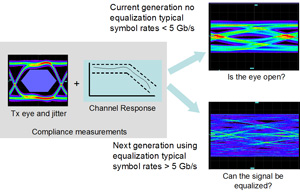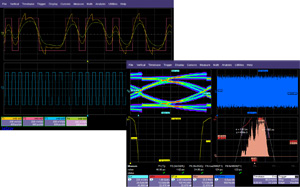Eye Doctor
Eye Doctor is a DSO-based instrumentation and simulation system which addresses these measurement challenges and is a dramatic leap in interoperability and compliance testing capability. Eye Doctor provides the tools to undo or compensate many common forms of distortion thereby increasing signal to noise, opening eyes, increasing rise time, reducing jitter restoring lost bandwidth and improving waveform fidelity.
|
As the symbol rates of systems have increased, the measurement challenges have also and with the adoption of receiver equalization, traditional jitter and noise measurements are becoming inadequate for determining interoperability. Eye Doctor is a DSO-based instrumentation and simulation system which addresses these measurement challenges and is a dramatic leap in interoperability and compliance testing capability. Eye Doctor provides the tools to undo or compensate many common forms of distortion thereby increasing signal to noise, opening eyes, increasing rise time, reducing jitter restoring lost bandwidth and improving waveform fidelity.
Measuring Equalized SystemsImperfections such as through holes, connectors, vias and package pins cause distortions in the high frequency content of high bit rate signals. The resulting eye is often closed or nearly closed. The traditional approach to interoperability testing involves measuring the channel response and the transmitter signal quality against compliance masks designed so that the signal eye and jitter will enable error-free operation. In an equalized system, the channel, transmitter and receiver are closely coupled and interoperability is determined by whether the signal can be equalized. What is needed is a method to quantitatively measure the interoperability of these systems.

Current generation serial data systems ensure interoperability using compliance measurements. Next generation systems employing equalization require new methods for determining interoperability. With the signal eye closed, traditional compliance measurements are no longer sufficient.
Eye DoctorEye doctor consists of two elements; Virtual Probing and equalized receiver emulation.
Virtual Probing enhances the accuracy of measurements made on distorted waveforms while equalized receiver emulation allows measurements to be made from a "receivers eye view." The ideal view of the signal within the receiver allows accurate total jitter and bit error rate measurements that are representative of actual system performance.
Virtual ProbingProbes and fixtures are not perfect and their presence in the circuit impacts both the loading on the DUT as well as the waveform seen by the oscilloscope. Virtual Probing is a powerful signal processing tool which enables the user to measure a signal anywhere within a system and then project a response at any other desired point. This feature works by using S-parameter files of the various components in the system to derive a filter which relates the desired measured signal to the acquired waveform. For example, measurements can be made where the cleanest signal is available, usually at the transmitter, and the corrupted signal at the far-end of the channel (at the end of the backplane) can be simulated thus eliminating probe and instrument noise from the measurement. The derived filter takes into account all of the interactions among the elements of the system and transmitter signal including differential to common mode conversion, nearend and far-end crosstalk.
Virtual Probing can be used to de-embed probe and fixture responses from measurements thereby improving the accuracy of signal integrity measurements.

Equalizer emulation simulates the signal as viewed within the receiver. The component can automatically determine the optimum weighting coefficients for both FFE and DFE with the number of taps for each selected by the user. Coefficients can also be entered directly. The full jitter analysis capability of the SDA is available on the equalized signal.
Equalizer EmulationEye Doctor features equalized receiver emulation which includes both Feed Forward Equalization (FFE) and Decision Feedback Equalization (DFE) along with clock recovery and a variable decision threshold. This ideal receiver reveals the signal as seen within a real receiver at the detector where it is impossible to probe. The equalized signal can be measured using the powerful jitter and signal analysis software in the SDA allowing the bit error rate, total jitter, and eye opening to be measured thus giving a precise indication of the performance margin. Because the receiver emulation is ideal, the margins are measured independently of measurement system and receiver noise.
SpecificationsEqualizer Emulation
- Up to 20 tap linear tapped delay line equalizer (transversal filter).
- PLL for clock recovery with variable loop bandwidth.
- Up to 20 tap Decision Feedback Equalizer (DFE) including erasure DFE.
- Clock skew adjustment.
- Outputs for equalized waveform (slicer input), data waveform (slicer output), and recovered clock.
- Error waveform output for user defined equalizer optimizations.
- Automatic blind adaptation using built-in LMS algorithms.
- Multi-level detection threshold supports duobinary and multilevel signaling systems.
- Provides waveforms that compensate for probe loading effects within bandwidth limitations of the system.
- Produces linear filters that operate on up to 8 inputs and provides up to 8 outputs.
- Simple text file system description similar to Spice.
- Accepts Touchstone format S-parameter file network device descriptions
- Includes simple device descriptions such as ideal tees, power splitter, open, short, thru plus lumped elements such as resistors, capacitors and inductors

 我要赚赏金
我要赚赏金

